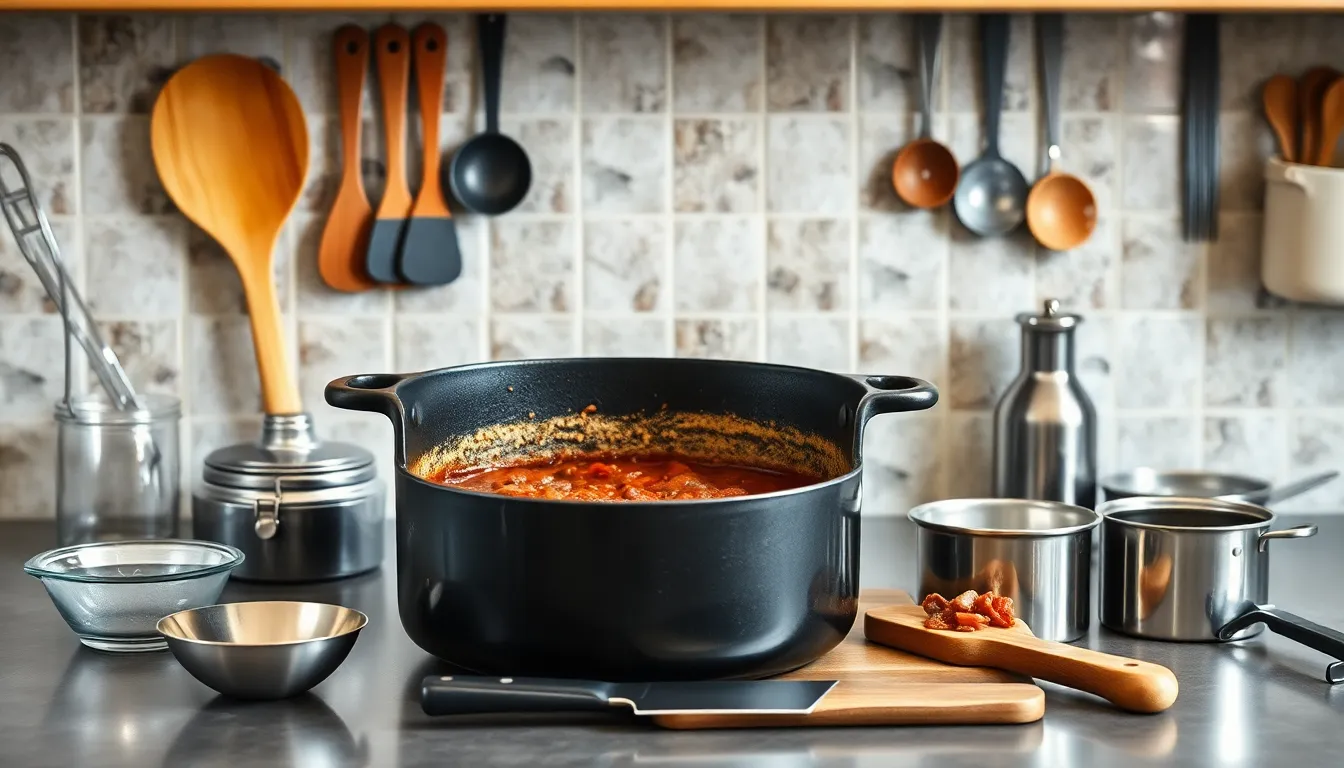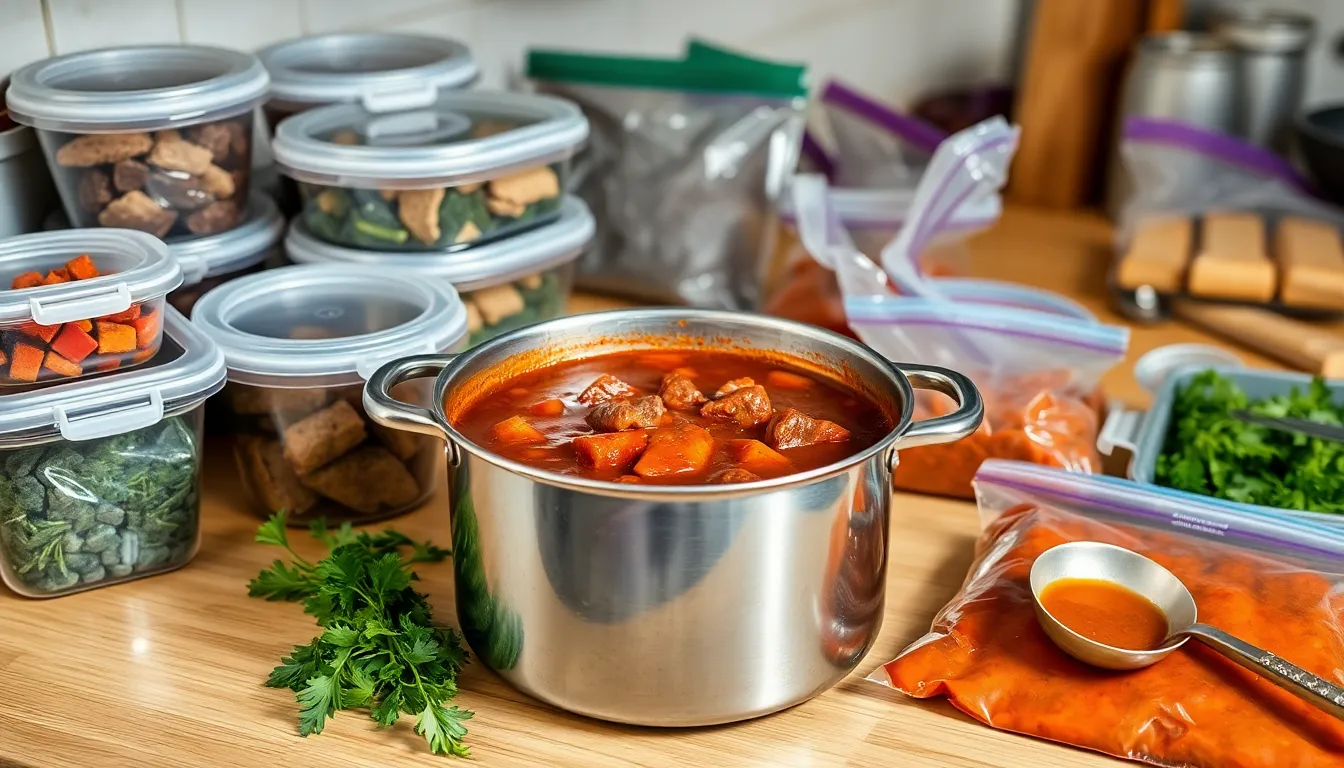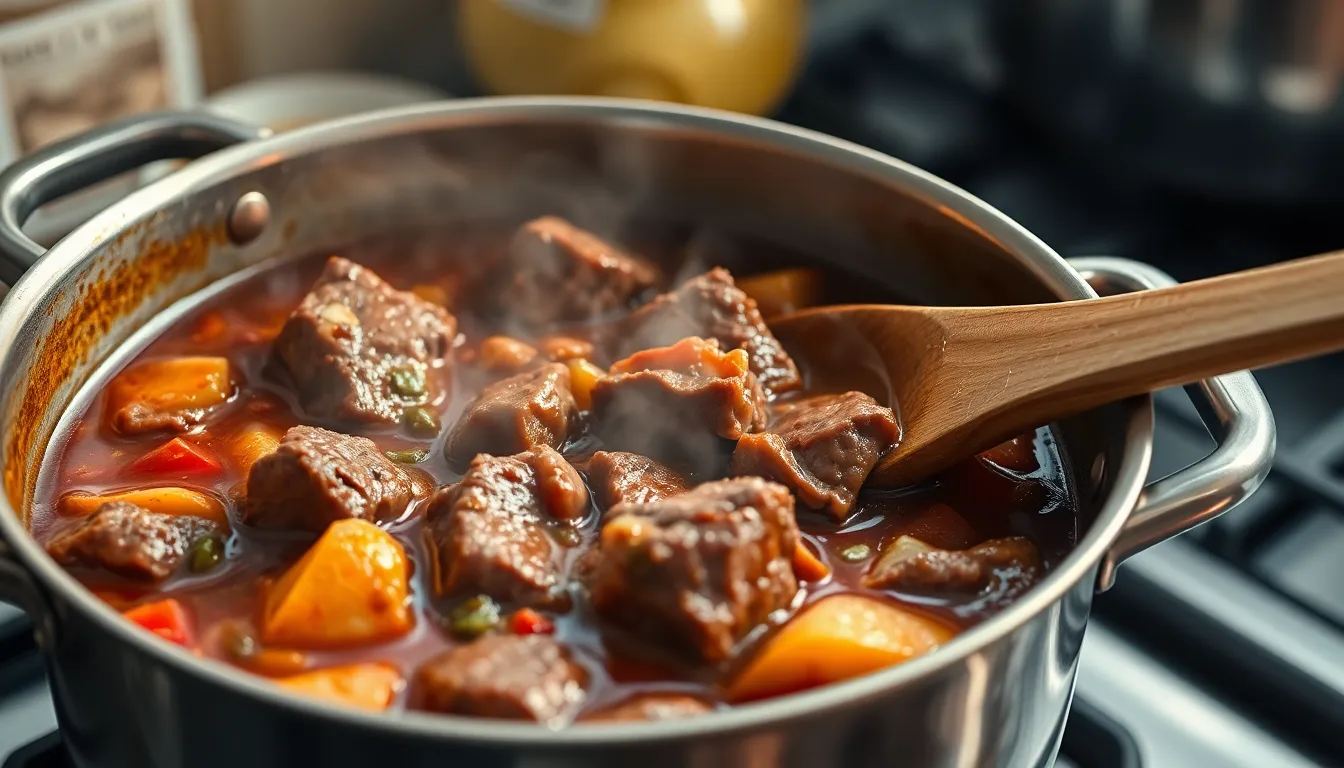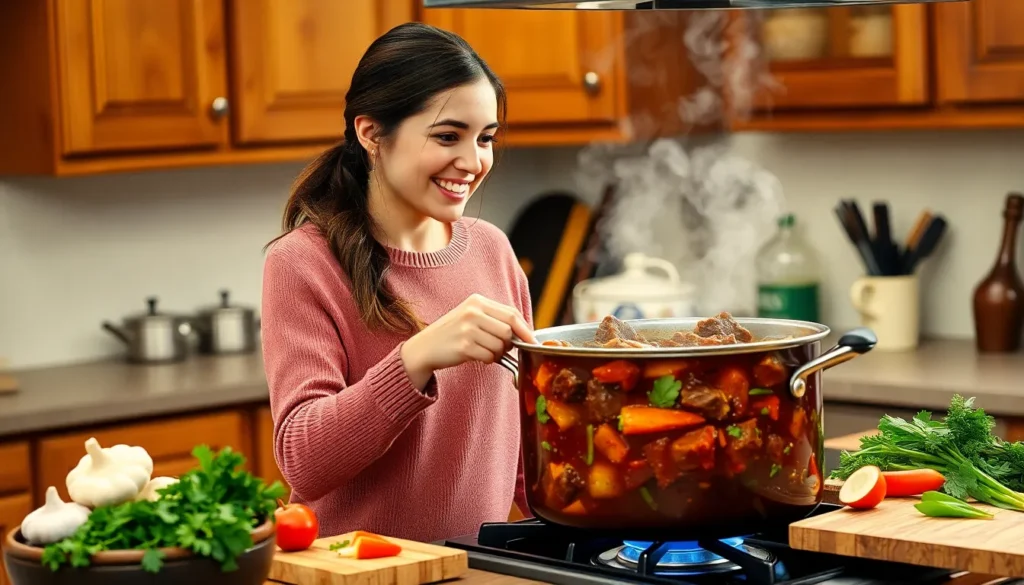The secret to an unforgettable beef stew lies in its rich, velvety sauce that transforms simple ingredients into pure comfort food magic. We’ve perfected this game-changing sauce recipe that’ll turn your ordinary stew into restaurant-quality perfection every single time.
This isn’t just any sauce – it’s the foundation that makes tender beef melt in your mouth while vegetables soak up incredible flavor. Our technique combines classic French cooking methods with foolproof steps that guarantee success, even for beginners. The deep, savory notes develop through careful layering of ingredients and proper timing.
What makes our beef stew sauce special is how it naturally thickens without flour clumps or artificial additives. We’ll show you exactly how to build those complex flavors from scratch using pantry staples. Once you master this sauce, you’ll never settle for thin, bland stew again.
Ingredients
Our beef stew sauce recipe combines simple pantry staples to create extraordinary depth of flavor. We’ve organized these ingredients by their role in building the perfect sauce foundation.
For the Base Sauce
- 3 tablespoons tomato paste
- 2 tablespoons olive oil or vegetable oil
- 4 cups beef broth (preferably low sodium)
- 1 cup red wine (dry variety like Cabernet Sauvignon or Merlot)
- 2 tablespoons Worcestershire sauce
- 1 tablespoon balsamic vinegar
- 2 bay leaves
- 1 teaspoon salt (adjust to taste)
- 1/2 teaspoon black pepper (freshly ground)
For the Flavor Enhancers
- 1 large yellow onion (diced)
- 4 cloves garlic (minced)
- 2 tablespoons butter (unsalted)
- 1 tablespoon brown sugar
- 1 teaspoon dried thyme
- 1 teaspoon dried rosemary
- 1/2 teaspoon smoked paprika
- 1/4 teaspoon ground allspice
- 2 tablespoons cornstarch (mixed with 3 tablespoons cold water)
Optional Garnish Ingredients
- 2 tablespoons fresh parsley (chopped)
- 1 tablespoon fresh chives (chopped)
- 1/4 cup sour cream
- Crusty bread rolls for serving
Equipment Needed

Creating our exceptional beef stew sauce requires the right tools to achieve that restaurant-quality texture and depth of flavor. We recommend gathering these essential pieces of equipment before starting your cooking process.
Large Dutch Oven or Heavy-Bottomed Pot serves as our primary cooking vessel. This equipment allows us to properly sear the beef and build those crucial flavor layers. A 6-quart capacity works perfectly for most family-sized batches.
Wooden Spoon or Heat-Resistant Spatula becomes indispensable for stirring and deglazing. We use this tool to scrape up those beautiful browned bits from the bottom of the pot that add incredible depth to our sauce.
Sharp Chef’s Knife and Cutting Board prepare our aromatics with precision. Fresh onions and garlic require proper chopping to release their maximum flavor potential into our sauce base.
Measuring Cups and Spoons ensure accuracy in our ingredient ratios. Our perfected sauce relies on precise measurements to achieve that signature balance of rich and savory notes.
Small Mixing Bowl creates our cornstarch slurry for thickening. We whisk the cornstarch with cold water in this separate container to prevent lumps from forming in our finished sauce.
Fine-Mesh Strainer removes any unwanted particles if needed. Some cooks prefer to strain their finished sauce for an ultra-smooth texture.
Ladle helps us serve the sauce with control and precision. This tool prevents spills and allows us to distribute the sauce evenly over our beef stew.
Can Opener opens our tomato paste and beef broth containers safely and efficiently. We recommend having a reliable opener since these ingredients form the foundation of our sauce.
Having these tools ready streamlines our cooking process and ensures we can focus on building those complex flavor layers that make our beef stew sauce truly exceptional.
Prep Work

We transform ordinary ingredients into an extraordinary beef stew through meticulous preparation. Our systematic approach ensures every element contributes to the sauce’s complex flavor profile.
Preparing the Aromatics
We start by chopping our fundamental aromatics that form the flavor foundation. Our onion gets diced into uniform pieces for even cooking and consistent flavor release. We measure out ½ teaspoon of garlic powder alongside our fresh herbs like rosemary and thyme.
The key step involves browning our beef and onions in olive oil before adding any liquids. This crucial technique develops deep flavors through the Maillard reaction. We sear the beef until golden brown on all sides while the onions become translucent and fragrant.
Our tomato paste joins the aromatics at this stage along with beef broth and optional red wine. The tomato paste adds both acidity and natural sweetness that perfectly balances the rich beef flavors. We scrape up any browned bits from the pan bottom during this process to capture every bit of developed flavor.
Measuring and Organizing Ingredients
We organize our ingredients by category to streamline the cooking process. Our protein section includes 2 pounds of trimmed and cubed stewing beef. The vegetable category contains 1 pound of peeled and cubed potatoes plus 4 carrots and 4 celery ribs cut into 1-inch pieces.
| Ingredient Category | Items | Measurements |
|---|---|---|
| Proteins | Stewing beef | 2 pounds, cubed |
| Vegetables | Potatoes, carrots, celery, peas | 1 pound, 4 each, ¾ cup |
| Liquids | Beef broth, red wine | 6 cups, ½ cup |
| Seasonings | Salt, pepper, garlic powder, rosemary | ½ tsp each, 1 tsp |
| Thickening | Flour, cornstarch | 3 tbsp, 2 tbsp |
Our liquid components include 6 cups of beef broth and an optional ½ cup of red wine. We measure our seasonings precisely: ½ teaspoon each of garlic powder, salt, and black pepper, plus 1 teaspoon of dried rosemary or 1 fresh sprig.
We prepare our thickening agents in advance with 3 tablespoons of all-purpose flour and 2 tablespoons of cornstarch mixed with water for our slurry. This preparation allows us to adjust the sauce consistency smoothly during the final cooking stages without creating lumps.
Instructions

We follow these systematic steps to create our exceptional beef stew sauce that transforms ordinary ingredients into restaurant-quality flavor. Our method ensures each component builds upon the last for maximum depth and richness.
Making the Roux Base
We begin by melting equal parts butter and all-purpose flour in our heavy-bottomed saucepan over medium-low heat. For our beef stew sauce, we use 1/4 cup of each ingredient to create the perfect foundation. We whisk continuously to combine the butter and flour while avoiding any scorching that could ruin our sauce.
Our goal is achieving a light brown roux that resembles peanut butter color after 5-6 minutes of constant stirring. This timing creates the ideal flavor profile for savory sauces without overpowering our beef stew. We monitor the color carefully since the roux type determines our final sauce character.
| Roux Type | Cooking Time | Color Description | Best Use |
|---|---|---|---|
| White | 1-2 minutes | Light, white | White sauces |
| Blond | 3 minutes | Pale golden | Light gravies |
| Light Brown | 5-6 minutes | Peanut butter | Beef stew, savory sauces |
| Dark Brown | 10 minutes | Rich chocolate | Creole/Cajun dishes |
Once we reach our desired light brown color, we remove the pan from heat and continue stirring as it cools to prevent separation.
Building the Sauce Foundation
We slowly incorporate our beef stock into the cooled roux while whisking vigorously to create a smooth, lump-free base. This gradual addition prevents the formation of any unwanted clumps that could affect our sauce texture. We add approximately 2 cups of warm beef broth in steady streams while maintaining constant whisking motion.
Our mixture should develop a silky consistency as we combine the liquid with our roux foundation. We return the pan to medium heat and bring our sauce base to a gentle simmer while stirring frequently. The sauce begins thickening immediately as the flour proteins activate and bind with our liquid ingredients.
We integrate this thickened base directly into our simmering beef stew, ensuring every piece of meat and vegetable gets coated with our rich sauce foundation.
Adding Seasonings and Herbs
We enhance our sauce with carefully selected seasonings that complement the beef without overwhelming the natural flavors. Our essential seasonings include 1 teaspoon of salt, 1/2 teaspoon of freshly ground black pepper, and 2 cloves of minced garlic for aromatic depth.
Fresh herbs elevate our sauce to professional standards. We add 2 sprigs of fresh thyme, 1 sprig of rosemary, and 2 bay leaves during the simmering process. These herbs infuse our sauce with complex flavors that develop over time.
For additional richness, we incorporate 1 tablespoon of Worcestershire sauce and 1 tablespoon of tomato paste once our roux and stock have combined. Some variations benefit from a splash of red wine or even Guinness beer for unique flavor profiles.
Simmering and Thickening
We bring our seasoned stew to a gentle simmer on the stovetop, maintaining consistent low heat to prevent scorching. Our sauce requires 20-30 minutes of patient simmering to achieve the proper consistency and develop full flavor complexity.
During this process, we stir occasionally to prevent any sticking while allowing natural reduction to concentrate our flavors. The sauce gradually thickens as the flour proteins fully activate and our liquid content reduces through evaporation.
If our sauce needs additional thickening, we prepare a small amount of butter-flour paste and whisk it directly into the simmering stew. This technique allows us to adjust consistency without starting over or creating lumps in our finished sauce.
We taste and adjust seasonings during the final 10 minutes of cooking, ensuring our beef stew sauce achieves the perfect balance of richness, depth, and seasoning intensity.
Cooking Tips for Perfect Consistency

Achieving the ideal consistency for your beef stew sauce requires mastering several key techniques that work together to create that restaurant-quality thickness and mouthfeel we all crave.
Mastering the Cornstarch Slurry Method
We recommend using a cornstarch slurry as our primary thickening agent since it delivers consistent results without the graininess that flour can sometimes create. Mix equal parts cornstarch and cold water in a small bowl until completely smooth. Add this mixture gradually to your boiling stew while stirring constantly. The key lies in patience – we add just a tablespoon at a time and allow each addition to incorporate fully before adding more.
| Cornstarch Slurry Ratios | Water | Cornstarch | Thickening Power |
|---|---|---|---|
| Light thickening | 2 tbsp | 2 tbsp | Coats spoon lightly |
| Medium thickening | 3 tbsp | 3 tbsp | Coats spoon well |
| Heavy thickening | 4 tbsp | 4 tbsp | Very thick consistency |
Strategic Flour Coating Techniques
Coating our beef pieces in seasoned flour before browning serves a dual purpose beyond just adding flavor. This technique creates natural thickening as the flour releases starch during the long simmering process. We toss beef cubes with flour, garlic powder, salt, and pepper before searing to ensure even coverage and maximum thickening potential.
Temperature Control for Optimal Results
Low and slow simmering proves essential for developing both flavor and proper consistency. We maintain a gentle simmer for 1 to 1.5 hours, which allows the beef to become tender while the sauce naturally reduces and concentrates. High heat breaks down vegetables too quickly and can cause the sauce to separate or become watery.
Liquid Management Strategies
Monitoring your liquid levels throughout cooking prevents both overly thin and overly thick results. We start with the full amount of beef broth called for in our recipe, then adjust during the final 30 minutes of cooking. Add small amounts of warm broth if the sauce becomes too thick, or remove the lid to allow excess moisture to evaporate if it seems too thin.
Tomato Paste Integration Method
Incorporating tomato paste correctly enhances both flavor depth and natural thickening properties. We cook the tomato paste with our aromatics for 2-3 minutes before adding liquids, which removes the raw taste and helps it blend seamlessly into the sauce base. This technique eliminates lumps and creates a smoother final texture.
Final Consistency Adjustments
Testing consistency during the last 10 minutes of cooking allows for perfect final adjustments. We look for sauce that coats the back of a spoon but still flows easily when stirred. The sauce should cling to the beef and vegetables without being gloppy or separating when the pot sits off heat for a few minutes.
Flavor Variations

We love experimenting with different flavor profiles to create unique beef stew experiences. These variations build upon our base sauce recipe while introducing distinctive taste elements that transform the entire dish.
Classic Herb Beef Stew Sauce
We consider this the foundation variation that showcases traditional comfort food flavors. Our classic herb sauce combines aromatic vegetables like onions, garlic, carrots, and celery with fresh thyme, rosemary, and bay leaves. We enhance the depth by incorporating tomato paste and Worcestershire sauce, which add rich umami notes that complement the beef perfectly.
The preparation involves browning flour-coated beef pieces first, then sautéing our aromatics until tender. We deglaze with beef broth, allowing the flour coating to naturally thicken the sauce as it simmers. This traditional approach creates a balanced, herbaceous flavor profile that delivers classic comfort food satisfaction.
| Ingredient | Purpose | Flavor Profile |
|---|---|---|
| Fresh thyme | Primary herb | Earthy, subtle |
| Rosemary | Aromatic depth | Pine-like, robust |
| Bay leaves | Background complexity | Subtle, woodsy |
| Worcestershire sauce | Umami enhancement | Savory, tangy |
Wine-Enhanced Sauce
We elevate our base recipe by incorporating red wine or Marsala wine to create sophisticated flavor complexity. The wine adds acidity and fruitiness that brightens the rich beef flavors while introducing elegant depth. We brown the meat and aromatics first, then deglaze the pan with our chosen wine before adding beef broth and seasonings.
Our wine-enhanced version often includes sun-dried tomatoes, which provide sweetness and concentrated flavor that pairs beautifully with the wine’s acidity. We simmer the sauce until the alcohol cooks off, leaving behind complex layers of flavor that transform simple ingredients into restaurant-quality results.
The wine’s acidity balances the richness of the beef, creating a more nuanced sauce that appeals to sophisticated palates. We recommend using a wine you would enjoy drinking, as the flavor concentrates during cooking.
Spicy Beef Stew Sauce
We create heat-forward variations by incorporating bold spices that add warmth and intensity to our base sauce. Our spicy version includes crushed red pepper flakes, chili powder, and smoked paprika alongside traditional seasonings. We maintain the same browning and simmering techniques while amplifying the flavor with carefully balanced heat elements.
The spicy components we add include ground black pepper, hot sauce, and sometimes cayenne pepper for those who prefer more intensity. We incorporate these spices early in the cooking process, allowing them to bloom and develop deeper flavors throughout the long simmering time.
Our spicy variation still maintains the rich, savory foundation while delivering a satisfying kick that warms from within. We adjust the heat level based on preference, starting with smaller amounts and building up to achieve the perfect balance of flavor and spice.
Storage and Make-Ahead Instructions

We can prepare our beef stew sauce ahead of time and store it properly to maintain its rich flavors. This allows us to enjoy restaurant-quality sauce whenever we need it.
Refrigerator Storage
Our finished beef stew sauce stays fresh in the refrigerator for up to 4 days when stored correctly. We should allow the sauce to cool completely before transferring it to an airtight container. Storing the sauce while it’s still warm creates condensation that can affect the texture and promote bacterial growth. Before reheating refrigerated sauce, we need to skim off any hardened fat that forms on the surface.
Freezer Storage
We can extend the sauce’s life by freezing it for up to 3 months in freezer-safe containers or bags. The key is cooling the sauce completely before freezing to prevent ice crystals from forming. We recommend dividing the sauce into portion-sized containers for easier thawing and use. For convenient single servings, we can freeze the sauce in ice cube trays and transfer the frozen cubes to freezer bags once solid.
Reheating Instructions
Reheating our beef stew sauce requires gentle heat to preserve its smooth texture. We should use a saucepan over low heat and whisk occasionally until the sauce warms through completely. The microwave offers another option by heating the sauce in short intervals while stirring between each heating cycle. Adding a splash of beef broth during reheating helps restore the sauce’s original consistency if it becomes too thick.
Serving Suggestions

Our beef stew sauce transforms into a complete meal when paired with the right accompaniments. We recommend starting with classic sides that complement the rich, savory flavors while providing the perfect base to soak up every drop of sauce.
Mashed potatoes stand as our top choice for serving alongside beef stew sauce. The creamy texture creates an ideal canvas for the thick, luscious sauce while adding comfort to every bite. We prefer buttery, well-seasoned mashed potatoes that won’t compete with the complex flavors we’ve built in our sauce.
Egg noodles offer another excellent foundation for our beef stew sauce. Wide egg noodles work particularly well because their broad surface area captures more sauce with each forkful. We cook them al dente to maintain their texture against the hearty sauce.
Buttery rice provides a neutral backdrop that allows our sauce’s wine and herb notes to shine. Long-grain white rice or wild rice both work beautifully, though we find that adding a pat of butter to the rice enhances the overall richness of the dish.
Crusty bread serves dual purposes in our serving strategy. Fresh dinner rolls or a rustic sourdough loaf not only complement the meal but also provide the perfect vehicle for dipping into any remaining sauce. We warm the bread slightly before serving to enhance its texture and aroma.
Our vegetable additions play a crucial role in creating a complete meal experience. Carrots and potatoes integrate seamlessly into the stew, absorbing the sauce flavors while adding substance and nutrition. We add celery for its subtle crunch and aromatic qualities that enhance the overall flavor profile.
Peas require special attention in our serving approach. We add them during the final 5 to 10 minutes of cooking to preserve their bright color and tender texture. This timing prevents overcooking while ensuring they absorb just enough sauce to tie into the dish’s flavor profile.
Mushrooms contribute an earthy depth that pairs exceptionally well with our wine-enhanced sauce variations. We sauté them separately before adding to maintain their texture and concentrate their flavors.
Fresh garnishes elevate our beef stew sauce presentation and add brightness to the rich dish. Fresh parsley provides a pop of color and a clean, herbaceous note that cuts through the sauce’s richness. We chop it finely and sprinkle it over the stew just before serving.
Fresh thyme works particularly well with our classic herb variation, reinforcing the aromatic profile we’ve built throughout the cooking process. A light sprinkle of fresh thyme leaves adds both visual appeal and a final layer of flavor complexity.
For those seeking additional richness, we suggest offering sour cream on the side. This allows diners to customize their experience while adding a cooling element that balances the sauce’s intensity.
Our serving temperature recommendations ensure optimal flavor delivery. We serve the beef stew sauce immediately after cooking while it’s hot and at its peak consistency. The sauce should coat the beef and vegetables without being too thin or overly thick.
Troubleshooting Common Issues

Even experienced cooks encounter challenges when perfecting their beef stew sauce. We’ve identified the most common problems and their answers to help you achieve consistent results every time.
Tough and Chewy Meat
When your beef emerges tough and rubbery instead of tender, the culprit is usually temperature management. Adding cold beef directly to boiling liquid creates proteins that seize up and become chewy. We always let our beef reach room temperature before searing, which typically takes 15-20 minutes on the counter.
High heat cooking compounds this problem by causing the meat fibers to contract rapidly. Our solution involves maintaining a gentle simmer at 320°F or lower, allowing the collagen in tougher cuts to break down naturally into gelatin. This low and slow approach transforms even the most challenging cuts into fork-tender pieces.
Watery and Bland Sauce
Nothing disappoints more than a thin, flavorless sauce that lacks body and depth. This issue stems from three primary causes: excessive liquid, insufficient fat, and inadequate seasoning. We combat watery sauce by reducing excess liquid through uncovered simmering, which concentrates the flavors naturally.
Fat plays a crucial role in creating richness and mouthfeel. When we skip the proper searing step or use too little oil, the sauce lacks the luxurious texture that makes beef stew memorable. Adding butter during the final minutes helps restore that silky consistency.
Seasoning adjustments throughout cooking prevent bland results. We taste and adjust salt levels multiple times during the cooking process, as flavors concentrate and change as liquids reduce.
Over-Thickened or Gluey Texture
Using too much flour creates an unnatural, gluey consistency that masks the beef’s natural flavors. The standard ratio of 2 tablespoons flour per 5 cups liquid prevents this common mistake. We toss the flour with seared beef cubes rather than adding it directly to liquid, ensuring even distribution without lumps.
When the sauce becomes too thick, we thin it gradually with warm beef broth, stirring constantly to maintain smoothness. Adding cold liquid to hot sauce can cause separation and create an uneven texture.
Acidic or Bitter Flavors
Red wine and beer add complexity but can overwhelm the sauce with harsh acidity or bitter notes. We balance these flavors by ensuring adequate fat content during the searing process, which mellows sharp edges. A pinch of baking soda neutralizes excess acidity without affecting other flavors.
Potatoes serve as natural acid absorbers when added during the final hour of cooking. They not only contribute to the meal’s substance but also help create a more balanced flavor profile. When wine dominates the taste, we dilute it with additional beef broth to restore harmony.
| Issue | Primary Cause | Solution | Prevention |
|---|---|---|---|
| Tough Meat | High heat cooking | Low temperature simmering (320°F) | Room temperature beef before cooking |
| Watery Sauce | Too much liquid | Uncovered simmering to reduce | Proper liquid ratios from start |
| Gluey Texture | Excessive flour | 2 tbsp flour per 5 cups liquid | Toss flour with beef, not liquid |
| Bitter Flavor | Too much wine/acid | Add fat, baking soda, or potatoes | Balance wine with adequate broth |
Temperature control remains the most critical factor in successful beef stew sauce creation. We monitor our cooking temperature carefully, adjusting heat as needed to maintain that gentle bubble that indicates proper simmering. This attention to detail prevents most common issues before they develop.
Conclusion
We’ve equipped you with everything needed to master the art of beef stew sauce creation. From understanding the essential ingredients and equipment to troubleshooting common issues you’re now ready to transform ordinary ingredients into extraordinary comfort food.
The beauty of this recipe lies in its versatility. Whether you choose the classic herb variation wine-enhanced version or spicy twist each delivers restaurant-quality results that’ll impress family and friends.
Remember that great beef stew sauce develops through patience and attention to detail. Don’t rush the process – let the flavors meld naturally and adjust seasoning as needed. With proper storage techniques you can even prepare this sauce ahead of time making weeknight dinners effortless.
Your kitchen will soon be filled with the incredible aromas of homemade beef stew sauce that rivals any restaurant dish.
Frequently Asked Questions
What makes the perfect beef stew sauce?
The perfect beef stew sauce combines rich, velvety texture with complex flavors. It uses natural thickening methods without flour or artificial additives, incorporating tomato paste, beef broth, red wine, and aromatic herbs. The key is building layers of flavor through proper browning, temperature control, and allowing ingredients to meld together naturally.
How do I thicken my beef stew sauce naturally?
Use a cornstarch slurry as the primary thickening agent by mixing equal parts cornstarch and cold water. Gradually incorporate it into the boiling stew while stirring constantly. You can also coat beef pieces in flour before browning and allow the sauce to reduce naturally through gentle simmering.
What are the essential ingredients for beef stew sauce?
The base includes tomato paste, olive oil, beef broth, red wine, Worcestershire sauce, balsamic vinegar, bay leaves, salt, and black pepper. Flavor enhancers include onion, garlic, butter, brown sugar, fresh thyme, rosemary, smoked paprika, and allspice. These ingredients create the foundation for a restaurant-quality sauce.
How long can I store beef stew sauce?
Properly stored beef stew sauce lasts up to 4 days in the refrigerator and up to 3 months in the freezer. Cool the sauce completely before storing to maintain quality. When reheating, use gentle heat and add beef broth if the sauce has thickened during storage.
What equipment do I need to make beef stew sauce?
Essential equipment includes a large Dutch oven for even heat distribution, a wooden spoon for stirring, a sharp chef’s knife for prep work, and accurate measuring cups. Having these tools ready streamlines the cooking process and helps you focus on building complex flavor layers.
How do I fix a watery beef stew sauce?
To fix watery sauce, create a cornstarch slurry and add it gradually while the stew simmers. Alternatively, remove the lid and allow excess liquid to evaporate through reduction. You can also remove some liquid, reduce it separately in a pan, then add it back concentrated.
What are some popular beef stew sauce variations?
Popular variations include Classic Herb Sauce with traditional aromatics, Wine-Enhanced Sauce using red or Marsala wine for complexity, and Spicy Sauce featuring bold spices like cayenne and paprika. Each variation builds on the base recipe while allowing for personal flavor preferences.
What should I serve with beef stew sauce?
Classic accompaniments include buttery mashed potatoes, wide egg noodles, or rice to absorb the rich sauce. Serve with crusty bread for dipping, and consider adding vegetables like carrots, potatoes, and peas. Fresh herbs like parsley and a dollop of sour cream make excellent garnishes.







